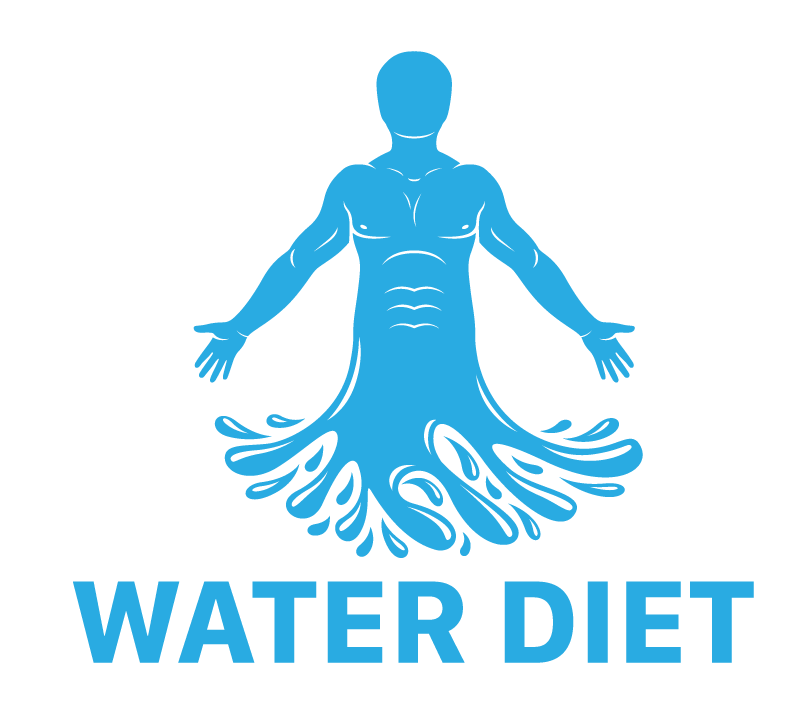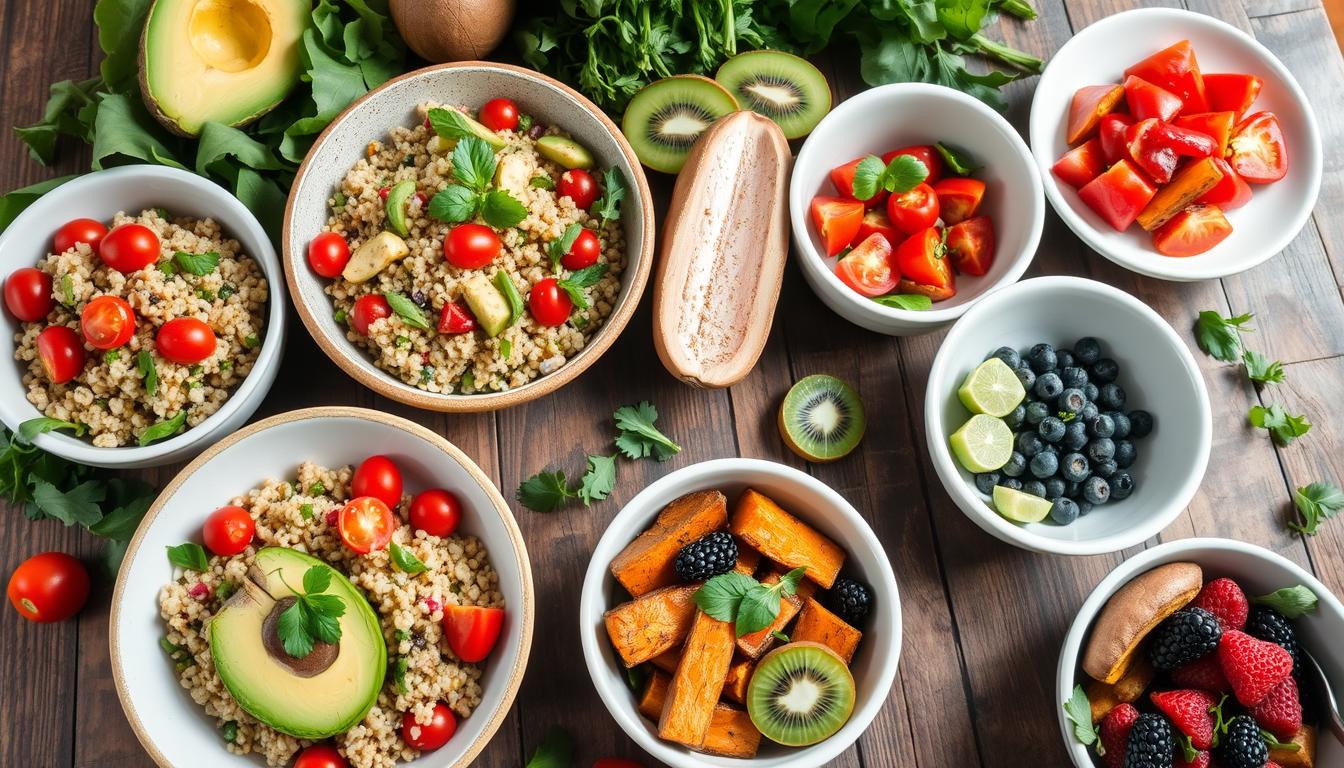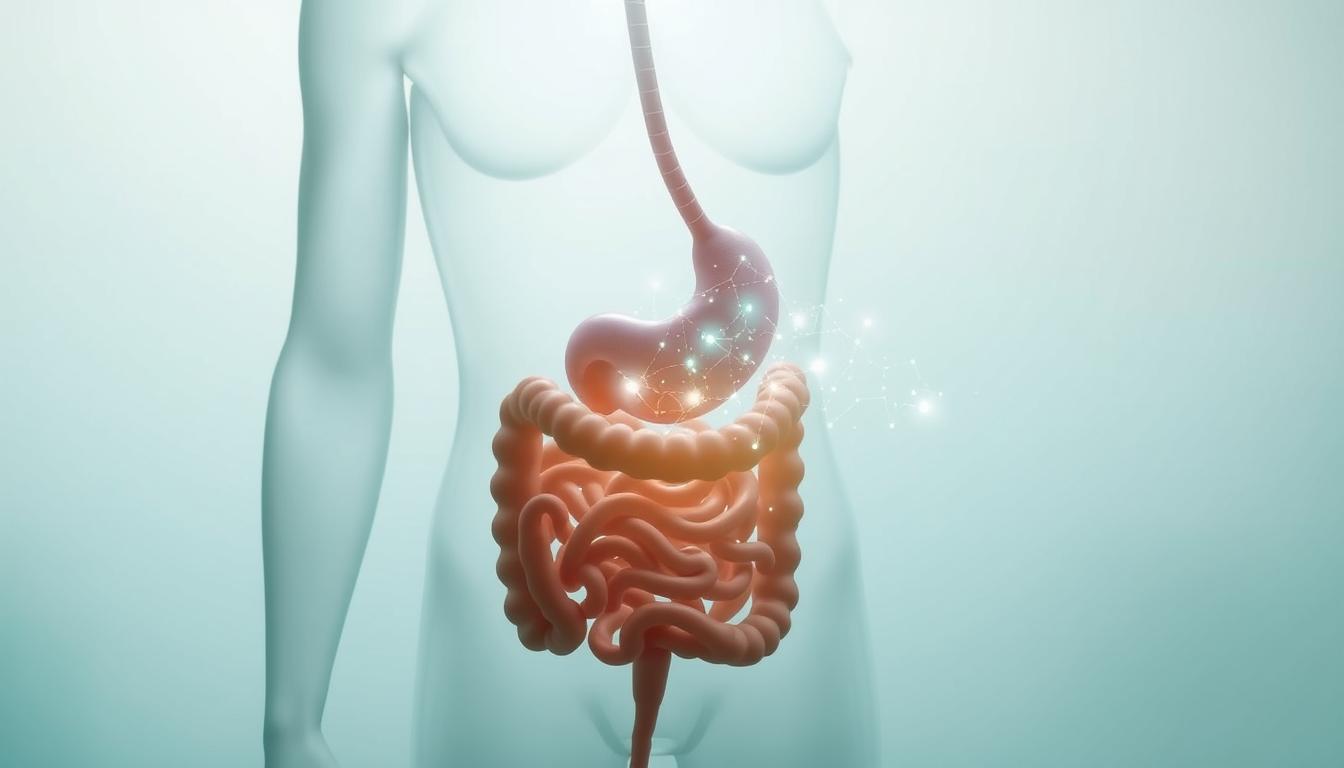Fasting is now a popular choice for health and weight loss. But, breaking a fast needs careful food choices for a smooth return to eating. It’s key to slowly add solid foods and nutrients to avoid digestive issues.
Start with small amounts of easy-to-digest, nutrient-rich foods. These should be low in fat, sugar, and fiber to avoid bloating. A good post-fast diet helps keep the fast’s benefits while giving your body what it needs.
Choosing the right foods after fasting is vital. Opt for nutrient-dense, easy-to-digest meals with balanced protein and healthy fats. Hydrating foods like watermelon and coconut water also help rehydrate your body.
As you add solid foods back, listen to your body. A thoughtful post-fast diet plan helps you smoothly return to regular eating. This way, you keep the fast’s benefits while getting the nutrients your body needs.
Key Takeaways
- Break a fast gently with small portions of easy-to-digest, nutrient-dense foods.
- Avoid foods high in fat, sugar, or fiber immediately after fasting to prevent digestive discomfort.
- Incorporate hydrating foods like watermelon and coconut water to support rehydration.
- Gradually reintroduce solid foods and listen to your body’s signals during the refeeding process.
- A well-planned post-fast nutrition plan can help maintain the benefits of fasting while providing essential nutrients.
Understanding Intermittent Fasting and Its Benefits
Intermittent fasting is becoming more popular as a healthy lifestyle choice. It involves eating in cycles, with periods of eating and not eating. This method focuses on when you eat, not what, helping your body recover and maintain itself.
Johns Hopkins neuroscientist Mark Mattson says humans used to go long without food. This was due to our ancient hunting and gathering ways. But today, we eat too much and move too little, leading to health problems.
Intermittent fasting has many benefits, including:
- Weight loss
- Improved blood sugar control
- Enhanced heart health
- Reduced inflammation
- Lowered risk of chronic diseases
Mattson’s research shows fasting burns fat after sugar is gone. This can make you leaner, live longer, and improve brain health. His studies were published in the New England Journal of Medicine.
“Intermittent fasting can enhance cognitive functions, improve heart health, aid in weight loss, benefit type 2 diabetes patients, and improve tissue health in animals.” – Mark Mattson
There are many types of intermittent fasting plans, such as:
| Fasting Plan | Description |
|---|---|
| 16/8 | Daily fasting for 16 hours and eating within an 8-hour window |
| 5:2 | Regular eating for five days and limiting calories to 500-600 for two days |
| 24-48 hour fasts | Fasting for 24 or 48 hours once or twice per week |
But, it’s not for everyone. It’s not good for those under 18, pregnant women, people with type 1 diabetes, or those with eating disorders. Some might feel anxious, have headaches, or nausea. Always talk to a doctor before starting.
It takes two to four weeks to get used to fasting. If it’s safe, you can keep doing it for a long time.
How Fasting Affects Your Body and Metabolism
Fasting is a powerful tool that can significantly impact your body’s metabolism and overall health. When you fast, your body undergoes a series of metabolic changes. These changes can lead to improved insulin sensitivity, reduced inflammation, and enhanced fat burning. Studies have shown that fasting can help lower the risk of chronic diseases such as diabetes, heart disease, and certain cancers.
One of the key ways fasting affects your metabolism is by inducing a state called ketosis. Ketosis occurs when your body shifts from using glucose (sugar) as its primary fuel source to burning fat for energy. This metabolic switch typically happens after 12-36 hours of fasting, depending on factors such as your individual metabolism and physical activity levels. During ketosis, your liver produces ketones, which can be used as an alternative fuel source for your brain and other organs.
Ketosis and Fat Burning During Fasting
When you fast, your insulin levels naturally decrease. This allows your body to tap into its fat stores for energy. As your body enters ketosis, it becomes more efficient at burning fat for fuel. This increased fat burning can lead to significant weight loss over time, as evidenced by numerous studies on intermittent fasting.
A 2017 study published in JAMA Internal Medicine found that alternate-day fasting resulted in weight loss, weight maintenance, and cardioprotection among metabolically healthy obese adults.
In addition to promoting fat loss, ketosis has been linked to other health benefits. These include reduced inflammation, improved brain function, and increased longevity. Some research suggests that the metabolic changes induced by fasting may even have neuroprotective effects. This could potentially reduce the risk of neurodegenerative diseases like Alzheimer’s and Parkinson’s.
Autophagy: The Body’s Self-Cleaning Process
Another fascinating aspect of fasting is its ability to stimulate autophagy. Autophagy is a natural process in which your body breaks down and recycles old, damaged, or dysfunctional cells and proteins. It’s often referred to as the body’s self-cleaning mechanism, as it helps to remove cellular debris and toxins that can contribute to aging and disease.
Research indicates that fasting can significantly increase autophagy. This allows your body to more effectively repair and regenerate itself. This process is thought to play a key role in the anti-aging and disease-prevention benefits associated with fasting.
| Fasting Duration | Effects on Metabolism and Health |
|---|---|
| 12-24 hours | Initiates ketosis and increases fat burning |
| 24-48 hours | Enhances autophagy and cellular repair |
| 48-72 hours | Promotes deeper ketosis and may improve insulin sensitivity |
It’s important to note that while fasting can offer numerous health benefits, it’s not suitable for everyone. Individuals with certain medical conditions, such as diabetes or eating disorders, should consult with a healthcare professional before attempting any fasting protocol. Additionally, prolonged fasts lasting more than 72 hours should only be undertaken under medical supervision to ensure safety and proper management of potential side effects.
Drinks You Can Consume While Fasting
Staying hydrated is key during fasting. Choosing the right drinks helps keep your fast going and your body nourished. Go for zero-calorie drinks that won’t break your fast or mess with fasting benefits like autophagy and fat burning.
Water and Carbonated Water
Plain water is top for staying hydrated during fasting. It has no calories and cleans out toxins. If plain water is too dull, try carbonated water or add lemon or cucumber for flavor without breaking your fast.
Coffee and Tea Without Added Sugars
Unsweetened coffee and tea are great for a caffeine boost during fasting. But, make sure they’re without added sugars, milk, or cream to keep your fast intact. If black coffee or tea is too strong, a bit of milk or fat can be added, but it might slightly reduce fasting benefits.
According to ZOE’s data, the amount of milk added to tea or coffee during fasting is generally not sufficient to cause blood sugar spikes for most individuals.
Apple Cider Vinegar Diluted in Water
Drinking diluted apple cider vinegar can help with hunger and cravings during fasting. Mix 1-2 teaspoons of apple cider vinegar in water. This drink is low in calories and can help with hydration and digestion, and even blood sugar control.
| Fasting-Friendly Drink | Calorie Content | Benefits |
|---|---|---|
| Water | 0 calories | Hydration, flushes out toxins |
| Black Coffee | Few calories | Caffeine boost, may suppress appetite |
| Unsweetened Tea | Few calories | Hydration, antioxidants |
| Diluted Apple Cider Vinegar | Low calorie | May curb hunger and cravings, improves digestion |
While these drinks are fasting-friendly, any drink with calories will break your fast. Stick to zero-calorie drinks to keep fasting benefits like fat burning and autophagy.
Foods to Avoid When Breaking a Fast
When you end a fast, it’s important to pick the right foods. Some foods can upset your stomach after fasting. This can cause discomfort and digestive problems. It’s best to avoid foods that might shock your system and cause side effects.
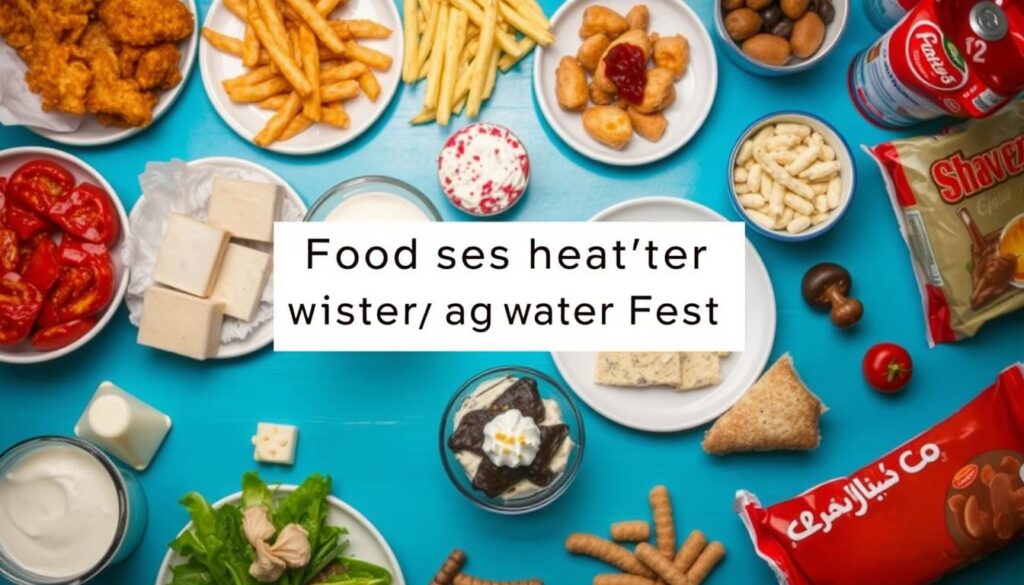
High-Fat, High-Sugar, and Processed Foods
Stay away from foods high in fat, sugar, and processing. These can be tough on your stomach. Your body’s digestive enzymes are lower after fasting. Foods like greasy burgers and sugary desserts can cause bloating and discomfort.
These foods are also low in nutrients. They can make your blood sugar spike, leading to energy crashes and cravings.
Examples of foods to avoid include:
- Fast food meals like cheeseburgers and french fries
- Sugary treats such as cakes, cookies, and candy
- Soda and other sugar-sweetened beverages
- Processed meats like hot dogs and sausages
- Packaged snacks like potato chips and crackers
Foods High in Fiber or Complex Carbohydrates
Be careful with foods high in fiber or complex carbs too. These are healthy but hard to digest right after fasting. Foods like raw fruits and vegetables, whole grains, and nuts can cause bloating if eaten too quickly or in large amounts.
Start with small portions and let your body adjust. This way, you can avoid discomfort.
Examples of foods to be mindful of include:
- Raw cruciferous vegetables like broccoli and cauliflower
- High-fiber fruits with skin, such as apples and pears
- Legumes and pulses like beans and lentils
- Nuts, seeds, and nut butters
- Whole grains like brown rice and whole wheat bread
“When breaking a fast, it’s important to choose foods that are easy to digest and gentle on your stomach. Avoiding high-fat, high-sugar, processed foods, and being cautious with high-fiber and complex carbohydrates can help prevent digestive discomfort and support a smooth transition back to regular eating habits.” – Dr. Sarah Johnson, Nutritionist
By avoiding these foods and choosing gentler options, you can smoothly transition back to eating. This helps keep the health benefits of fasting.
Gentle Foods to Break a Fast and Ease Digestion
Choosing gentle foods is key when breaking a fast. Your digestive system is more sensitive after fasting. So, it’s best to start with foods that are easy to digest and packed with nutrients. Here are some good options:
Smoothies and Blended Drinks
Smoothies and blended drinks are great for breaking a fast. They have less fiber than raw fruits and veggies, making them easier to digest. Mix in fruits, veggies, and a protein source like Greek yogurt or plant-based protein powder. But, avoid sugary or high-fat ingredients to keep your stomach happy.
Soups with Easily Digestible Ingredients
Soups are also a good choice. They’re hydrating and full of nutrients in a form that’s easy on your stomach. Opt for soups with ingredients like lentils, tofu, or pasta. Stay away from soups with heavy cream or lots of raw, high-fiber veggies. Bone broth soups are especially good because they’re full of nutrients and minerals that help your gut.
| Soup Ingredient | Benefits |
|---|---|
| Lentils | High in protein, fiber, and essential nutrients |
| Tofu | Easy to digest, low in fat, and rich in protein |
| Pasta | Provides carbohydrates for energy and is gentle on the stomach |
Cooked, Soft Vegetables
Cooked, soft veggies like potatoes, sweet potatoes, and squash are great for breaking a fast. They’re full of nutrients and easy to digest. Try steaming, baking, or boiling them to make them even softer. Avoid raw or high-fiber veggies that can be hard on your stomach.
According to a review published in the Annual Review of Nutrition in July 2017, intermittent fasting may aid in weight loss. However, the Academy of Nutrition and Dietetics states that the weight loss outcomes between fasting and low-calorie diets do not differ significantly.
When breaking a fast, eat nutrient-dense, easy-to-digest foods in small amounts. This helps you get the nutrients you need without upsetting your stomach. Opt for smoothies, blended drinks, soups, and cooked veggies to ease back into regular eating.
Nutrient-Dense Foods to Replenish Your Body
After fasting, it’s key to feed your body with foods rich in vitamins and minerals. These foods help refill your body’s stores and support your health as you start eating regularly again. Choose whole, minimally processed foods that have healthy fats, lean proteins, and complex carbs.
Bone broth is a great choice for post-fast nutrition. It’s packed with vitamins B2, B12, E, and A, and minerals like iron, calcium, and magnesium. It also has collagen and gelatin, which are good for your gut and digestion.
Eggs are also a good choice. They have high-quality protein and healthy fats. These are important for cell repair, immune function, and muscle building. Eggs also help you feel full and satisfied, preventing overeating.
Oily fish, like salmon, mackerel, and sardines, are full of omega-3 fatty acids and protein. These fats reduce inflammation, support brain function, and are good for your heart. Adding these fish to your meals can offer many health benefits.
When picking fruits and vegetables to break your fast, choose nutrient-dense ones like:
- Leafy greens (spinach, kale): These veggies are full of vitamins and minerals that support your body.
- Berries (blueberries, strawberries): Berries are packed with antioxidants, fiber, and vitamin C. They help reduce inflammation and boost your immune system.
- Avocados: Avocados are rich in healthy fats, fiber, and potassium. They’re a nutritious choice for breaking a fast.
| Nutrient-Dense Food | Key Nutrients | Benefits |
|---|---|---|
| Bone Broth | Vitamins B2, B12, E, A, iron, calcium, collagen, gelatin | Supports gut health, aids digestion, promotes hydration |
| Eggs | High-quality protein, healthy fats, vitamin D, choline | Cell repair, immune function, muscle formation, satiety |
| Oily Fish (Salmon, Mackerel) | Omega-3 fatty acids, protein, vitamin D, selenium | Reduces inflammation, supports brain and heart health |
| Leafy Greens (Spinach, Kale) | Vitamins A, C, K, folate, iron, calcium | Supports bodily functions, promotes overall health |
By eating nutrient-dense foods when breaking your fast, you give your body what it needs to recover and thrive. Listen to your body’s hunger cues and eat mindfully. Enjoy each bite and appreciate the nourishment these foods provide.
Breaking a Water Fast: Foods to Eat After Fasting
When you end a water fast, picking the right foods is key. You want to choose foods that are easy on your stomach. This helps you avoid feeling sick and makes the transition smoother. Here are some great foods to consider:
Dates and Dried Fruits
Dates are a top pick for ending a fast. They’re full of nutrients, fiber, and natural sugars. These sugars give you energy without upsetting your stomach. Apricots and raisins are also good, offering similar benefits and helping your body’s energy stores.
Fermented Foods like Unsweetened Yogurt or Kefir
Fermented foods, like unsweetened yogurt or kefir, are great choices. They’re full of probiotics that help your gut health and digestion. These foods can also help balance the good bacteria in your stomach, which fasting can affect. Choose unsweetened options to avoid sugars that might upset your stomach.
Healthy Fats from Eggs and Avocados
Healthy fats from eggs and avocados are also good. Eggs are packed with protein and nutrients and are easy to digest. Avocados offer healthy fats, fiber, and vitamins and minerals. These fats help you feel full and give you energy as you start eating again.
Remember to keep portion sizes small when breaking a fast, as your body may need time to adjust to processing solid foods again. Gradually increasing your intake over the course of a few days can help prevent digestive issues and ensure a successful transition back to your normal eating routine.
Hydrating Foods to Support Rehydration
Drinking lots of fluids is key after fasting. But eating hydrating foods also helps. Fruits and drinks with lots of water and electrolytes are great for rehydration.
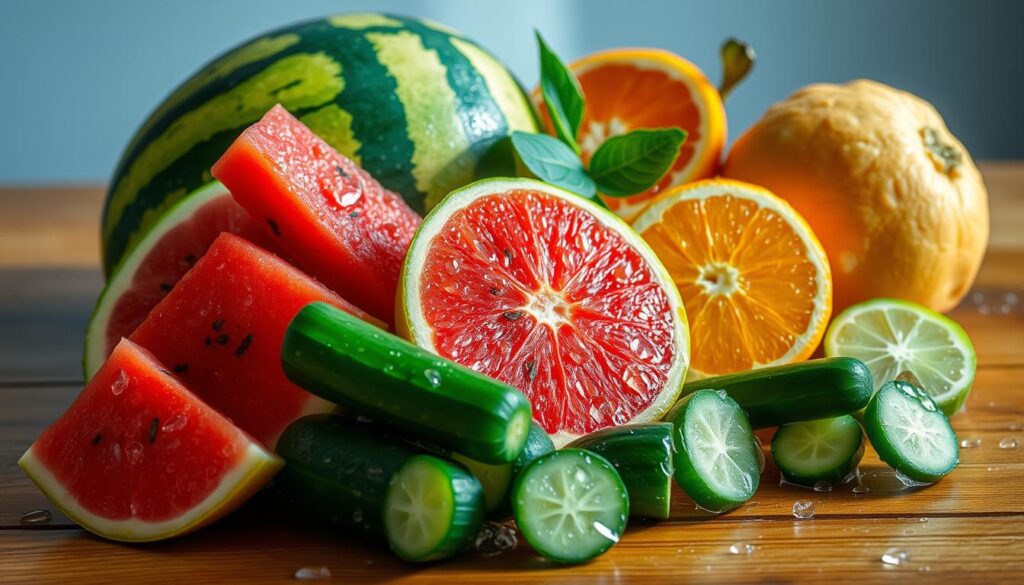
Watermelon and Other Water-Rich Fruits
Watermelon is perfect for rehydrating after fasting. It’s over 90% water and packed with vitamins A and C. Its water helps replace lost fluids, and its sugars give a gentle energy boost.
Other fruits like cantaloupe, grapefruit, strawberries, peaches, and oranges also help. They’re full of water and vitamins, minerals, and antioxidants for health.
Coconut Water and Its Electrolyte Content
Coconut water is great for hydration after fasting. It has potassium, magnesium, and sodium, important for hydration and body functions. Its electrolytes help replace what’s lost during fasting, especially if you sweated a lot.
| Electrolyte | Amount per 8 oz (240 ml) |
|---|---|
| Potassium | 600 mg |
| Magnesium | 60 mg |
| Sodium | 252 mg |
| Calcium | 58 mg |
Choose coconut water with less added sugar to avoid extra calories. Some people mix it with water to cut down on sweetness and calories.
Adding hydrating foods like watermelon and coconut water to your meals after fasting helps your body rehydrate. It makes the transition back to eating easier.
Gradually Reintroducing Solid Foods and Proteins
When you start to eat solid foods again, it’s important to do it slowly. Start with lean proteins like eggs, fish, chicken, or tofu. These foods are easy to digest and help your body repair muscles.
Plant-based proteins like beans, peas, and lentils are also good. You can add them to soups or stews. They’re full of nutrients and fiber, great for vegetarian or vegan diets.
Listen to your body when you start eating these foods again. If you feel uncomfortable, slow down. Eating too much too fast can cause bloating or stomach pain.
“Chewing your food thoroughly is crucial for supporting optimal digestion and nutrient absorption, particularly when breaking a fast. Take the time to savor each bite and allow your digestive system to adjust gradually.”
As you get used to eating solids, you can try more foods. Add complex carbs like quinoa, brown rice, and sweet potatoes. Also, eat fiber-rich veggies and fruits, and healthy fats from avocados, nuts, and seeds.
The key to breaking a fast is to do it slowly and focus on easy-to-digest proteins. Eating nutrient-rich foods and listening to your body helps you smoothly return to regular eating. This way, you can improve your health and well-being.
| Protein Source | Benefits |
|---|---|
| Eggs | Rich in essential amino acids, choline, and healthy fats |
| Fish | Provides omega-3 fatty acids, promotes heart and brain health |
| Chicken | Lean protein source, supports muscle growth and repair |
| Tofu | Plant-based protein, contains isoflavones and beneficial nutrients |
By slowly adding solid foods and lean proteins, you can break your fast well. This supports your body’s nutritional needs and overall health.
Common Mistakes to Avoid When Breaking a Fast
When you start eating again after fasting, it’s key to avoid common mistakes. These mistakes can make your transition back to eating harder. They can also cause stomach issues or health problems.
Overeating or Consuming Large Portions
Many people eat too much when they break their fast. Feeling very hungry after fasting can make you want to eat a lot. But eating too much can upset your stomach and undo some of the fasting benefits.
To avoid eating too much, eat slowly and mindfully. Listen to your body’s hunger and fullness signals. Use a scale from 0 to 10 to know when you’re full. Start with small meals after fasting to help your body adjust.
Choosing Unhealthy, Processed Foods
Another mistake is eating unhealthy, processed foods. Foods high in sugar, unhealthy fats, and additives might seem tempting. But they can be hard to digest and cause inflammation.
Instead, choose whole, healthy foods. Eat fruits, vegetables, lean proteins, and healthy fats. These foods help your body recover and stay healthy. Stay away from processed foods, sugary snacks, and fried foods to avoid digestive issues.
| Foods to Avoid | Healthier Alternatives |
|---|---|
| Fried foods | Baked or grilled lean proteins |
| Sugary snacks and desserts | Fresh fruits and unsweetened yogurt |
| Processed meats | Grilled chicken or fish |
| Refined carbohydrates | Whole grains and legumes |
Avoiding these mistakes and eating mindfully helps your body adjust to eating again. Focus on eating whole, nutritious foods. Listen to your body’s hunger and fullness signals for a healthy break from fasting.
Sample Meal Plan for Breaking a Water Fast
When you end a water fast, having a good sample meal plan is key. It helps you choose the right foods and makes the transition back to eating easier. Start with gentle, nutrient-rich foods and slowly increase your portions. This helps your body heal and avoids stomach upset.
Breakfast Options
For your first meal, pick something light and nutritious:
- A smoothie with hydrating fruits, a bit of protein powder, and unsweetened almond milk
- Unsweetened yogurt with berries and a touch of raw honey
- Bone broth with a soft-boiled egg and avocado
Lunch and Dinner Ideas
As you move through your meal plan, add these lunch and dinner ideas for essential nutrients:
- A vegetable soup with chicken or tofu and easy-to-digest veggies like zucchini and carrots
- A small salad with cooked veggies, lean protein, and a dressing
- Bone broth with soft veggies and a small amount of quinoa or brown rice
Snacks and Beverages
Healthy snacks and drinks help with recovery and keep you hydrated:
| Snacks | Beverages |
|---|---|
| A small handful of raw, unsalted nuts like almonds or walnuts | Water (plain or carbonated) |
| Sliced cucumber or celery with hummus | Herbal tea (unsweetened) |
| A piece of fresh fruit, such as an apple, pear, or peach | Coconut water (unsweetened) |
Listen to your body and adjust your meal plan as needed. If you feel uncomfortable or overwhelmed, start with simpler foods. This helps your body adjust.
By following this meal plan and slowly adding different foods, you can safely end your water fast. This sets you up for a healthy eating pattern.
Tips for a Successful Transition Back to Regular Eating
When you start eating again after fasting, it’s important to eat mindfully. Take your time and chew well, enjoying each bite. Pay attention to when you’re hungry and when you’re full. This helps you eat just the right amount.
It’s also crucial to eat balanced meals. Include lean proteins, healthy fats, and complex carbs. These foods help nourish your body. If you feel uncomfortable or bloated, try digestive enzymes to help your body digest food better.
Give yourself time to adjust to eating again. It’s normal to feel some changes. Don’t worry if things don’t go perfectly at first. The goal is to nourish your body and improve your health. With patience and consistency, you’ll find a healthy eating routine that suits you.
